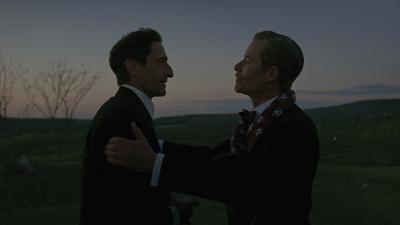I dare anyone to not think about what’s going on in the world while watching The Brutalist.
As we dive headfirst into four more years of (likely) mayhem, once again fueled by an orange agent of chaos and the knuckleheads who sent him back to the Oval Office, The Brutalist — which recently earned multiple Golden Globes — is an ambitious period piece that speaks more about our time than the time in which the movie is set. With said agent and his knuckleheads going on a rabid mission to rid our country of anyone who dares to cross our borders and build a better life for themselves (Haven’t you heard? They’re eating the pets!), The Brutalist spends three-and-a-half hours — don’t worry, there’s a 15-minute intermission — telling the story of one such person.
Adrien Brody, who became the youngest Best Actor winner in Oscar history for his role as a talented Holocaust survivor in 2002’s The Pianist, once again escapes hell — this time as a Hungarian-born Jewish architect named László Tóth. Although he happens to have the same name as a geologist who vandalized Michelangelo’s “Pietà” in 1972, this Tóth is serious about his art. An accomplished practitioner of a minimalist postwar style that eventually becomes known as Brutalist architecture, he comes to America after surviving the Holocaust, looking for all that opportunity he keeps hearing about.
His journey from immigrant to architectural genius comes with more lows than highs. His beloved wife Erzsébet (Felicity Jones) isn’t with him at first, as she’s still stuck in Hungary with their niece. When they both finally come to America in the film’s second half, Erzsébet is in a wheelchair — the result of osteoporosis due to malnutrition. Tóth initially lives with his furniture-making cousin (Alessandro Nivola), but he’s kicked out when his cousin’s wife accuses Tóth of hitting on her. Ol’ boy even gets hooked on heroin, often sharing the needle with a single father (Isaach de Bankolé) who becomes his right-hand man.
Tóth achieves success when he gets with Harrison Lee Van Buren (Guy Pearce, devilish and blustery), a wealthy industrialist. Tóth first meets Van Buren after being hired to renovate his home library by Van Buren’s son (played with loathsome sketchiness by Joe Alwyn). Van Buren ropes Tóth into his world, getting him to design a massive community center that eventually becomes the bane of both their existences.
Actor-turned-director Brady Corbet (Vox Lux) goes into ambitious-auteur mode here, becoming the latest filmmaker to masterfully pull off an epic, original production using old-school film stock for both 35 mm and 70 mm prints. (The good news: The Belcourt will be showing The Brutalist in glorious 35 mm! The bad news: If you want 70 mm, you’ll have to go out of town.) Since the film mostly takes place in the same era that gave us Vertigo and The Searchers, it’s fitting that Corbet would shoot this thing in VistaVision, a higher-resolution widescreen variant that was created in the 1950s and used for those films. Corbet and cinematographer Lol Crawley often hit us with some breathtaking visuals, creating a vast, sprawling atmosphere that our protagonist still manages to feel trapped in.
Corbet and his co-writer and romantic partner Mona Fastvold definitely show their allyship with all the immigrants who ever had to struggle just to get something going in the States. No matter how much Brody’s temperamental artist tries to maintain his creative principles, he ultimately ends up in situations where he is screwed over.
“They do not want us here,” an angry, embittered Tóth tells his wife at one point, certainly the kind of sentiment a lot of both documented and undocumented folks have been uttering these days. While all this may make The Brutalist sound like a misery marathon, it’s really Corbet giving flowers to the immigrants who stuck it out and continue to stick it out.
Just like the Statue of Liberty, which Tóth frantically hops out of a boat to look at during the movie’s opening, many of the American figures that most represent life, liberty and the pursuit of happiness in the country didn’t originally come from here. Given the film’s conclusion and epilogue, The Brutalist’s pro-immigrant stance couldn’t be more clear. Some Americans may not want them here, but since they basically built this country, immigrants ain’t going nowhere. Hell, they’ll be here longer than you.





